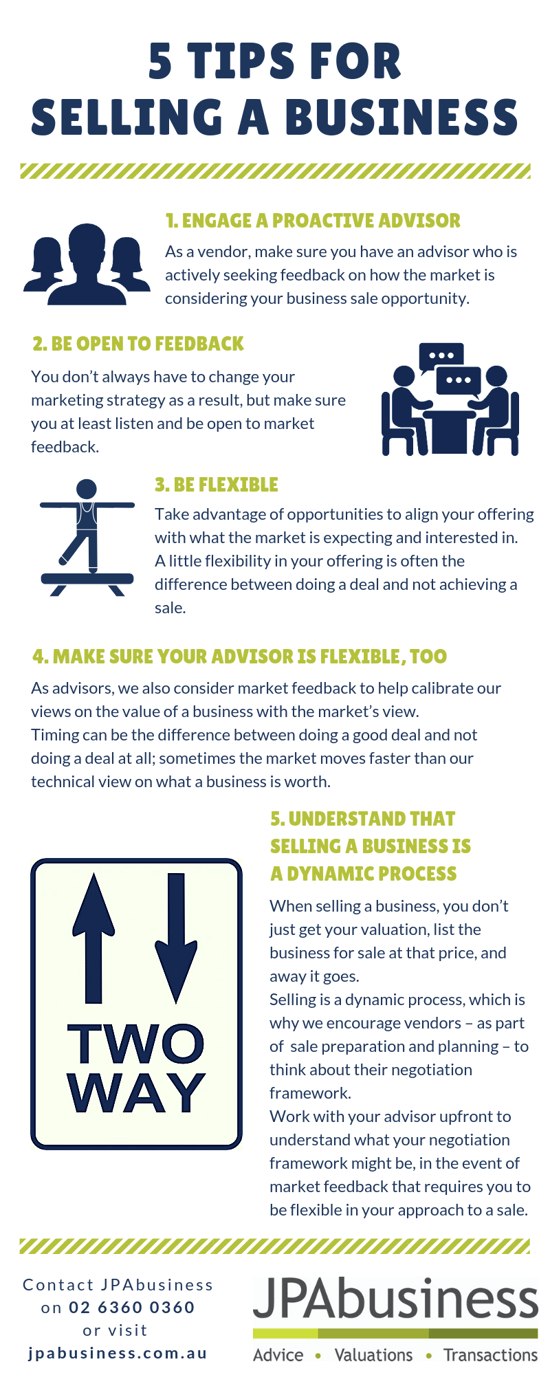
A few years ago we facilitated a business sale for a long-term client in south-west Victoria. The client operated an industrial services and utilities business that had been operating for over 20 years.
Some facts and figures about the business include:
- about 20 staff
- a turnover of around $5 million
- earnings before interest, tax and depreciation in the order of $650,000 per annum.
Preparing to exit
The client had engaged us several years earlier to conduct a valuation on the business, in preparation for a potential exit in the future.
They weren’t at retirement age, but had developed other business interests and were considering transitioning to a different industry to pursue them.
At the time we valued the business at $2.4 million.
Sales process begins
About 12 months later the client came back and asked us to officiate a sale process.
We confirmed the value at that stage in a range between $1.9m and $2.4m.
We then commenced a detailed marketing program and identified a number of parties interested in the opportunity.
Disappointing response
In the ensuing months there were at least four parties who showed considerable interest in the business.
However only two of those made offers for the business and their offers ranged from $1.3m to $1.6m – substantially below what we believed was the fair market price for the business.
Despite various negotiations, we weren’t able to get those parties up to the price range we anticipated the market should be paying.
Valuable market feedback received
The reasons they gave for offering in this price range included the following:
- Heavy reliance on the current business owner, even though he had employed a management team and therefore somewhat minimised the risk that his departure would impact the fortunes of the business.
- The market for this particular business’ products and services was very competitive.
- There were cases of companies falling on hard times and therefore margins were contracting in the market.
- This meant the business operated in what was regarded as a somewhat difficult industry and that impacted on value, even though our client’s performance and profit margin was very solid.
There were other factors encountered, including the inability of some interested parties to raise finance beyond the base value of the business’ plant and equipment. As a result they were unable to bid up strongly to cover the full going concern value of the enterprise.
Responding to the feedback
Twelve months passed.
Eighteen months passed.
There was still interest in the business, but it was very hard to see a deal being done that met our initial expectations of market value.
As a result we spoke to our client and said:
“We have a couple of options.
“We appraised the business at $1.9m–$2.4m and we still believe that, technically, it is reasonable value for the business given its performance.
“However the market is telling us otherwise.
“Do we meet the market and try to repackage the pricing and other offerings, or do we sit and wait for the market to catch up to our expectations?”
This sort of choice is difficult and ultimately comes down to the vendor’s motivations in terms of timing.
You can set a price for a business that might be regarded as overpriced today, but with time the market can catch up. In other cases, time may be against you and the market never catches up!
Repackage and meet the market
Our vendor was quite open to the market feedback we had extracted from the interested parties.
As a result we repackaged the business offering and relaunched the sale process.
Key factors of this new, repackaged offering were:
- $1.6m sale price
- Vendor agreed to continue working in the business for 12 months
- Vendor agreed to leave a small percentage of the purchase price in the business to be paid as an earnout at a later date. (Earnout clauses are dependent on future earnings and so ‘mitigate the risk’ to an incoming purchaser of a potential decline of a business when a vendor moves on.)
Long story short, the business is now sold and the deal offered above was the end deal that delivered the sale.
So was the sale a success or failure?
On face value, the price received was very different to the starting number.
However the vendor was happy to achieve a sale at an acceptable price in the shorter term, rather than wait for a possible sale at a higher price, down the track.
The vendor was able to move on and take up some of the new opportunities they were focused on.
5 key lessons for business sellers
The following infographic sums up 5 lessons we think this experience can provide for other sellers.

JPAbusiness offers a range of business advisory and business transaction services. If you would like advice about buying or selling a business, contact the team on 02 6360 0360 (Orange) or 02 9893 1803 (Parramatta) for a confidential initial discussion.
 James Price has over 30 years' experience in providing strategic, commercial and financial advice to Australian and international business clients. James' blogs provide business advice for aspiring and current small to mid-sized business owners, operators and managers.
James Price has over 30 years' experience in providing strategic, commercial and financial advice to Australian and international business clients. James' blogs provide business advice for aspiring and current small to mid-sized business owners, operators and managers.

